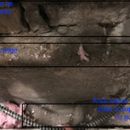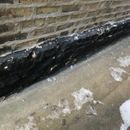Basement insulation and wall re-build
I’m hoping someone here can give me some advice on insulation my basement appropriately. I had some mild moisture issues and had to pull up the interior drywall on an exterior wall. Some moisture was coming through but no standing water. It is an older Chicago house with a brick foundation. I pulled out the insulation batt that was there and plan on having the wall insulated with closed cell spray foam. In the attached picture you can see that the outside of the wall above grade has some type of tar attached to it. If I have the inside spray foamed should I have this tar removed? I have read about the dangers of having an inside vapor barrier and outside vapor barrier and subsequent trapping of moisture in the wall. I figured that if the inside is spray foamed then outside should not have a barrier. Should the exterior brick be covered with something else or the corner of the wall and gangway caulked? Any help would be appreciated!
Thanks,
Fes
GBA Detail Library
A collection of one thousand construction details organized by climate and house part












Replies
Hey Fesbuilder,
As I've recently dealth with crazy basement stuff with my current reno, I've spent a lot of time researching and getting help on here regarding stuff like this. hopefully I can offer adequate insight to pay it forward.
Waterproofing from the outside:
That black tar on the exterior, can you confirm it actually goes below grade? or all the way down? from the photo it looks like it stops at the exterior slab. I wouldn't be surprised that at some point someone paid for waterproofing and the contractor just painted on tar above grade and called it a day. Also To my understanding, Tar isn't very good for underground applications, and a stonewall has such variation with the crevasses that its hard for any material to maintain longevity. I'd imagine something like mortaring the outside and using aquablock or a similar elastomeric waterproofing compound.
Waterproofing from the inside:
I personally don't see anything wrong with spray foaming the inside, closed cell 2lb spray foam is supposed to be a pretty good barrier. Make sure its able to drain at the bottom to an interior weeping system (if you have one, if you don't, now is a very good time to put one in)
When you're referring to the dangers of a moisture trap, that's usually meant for having a vapor barrier on the inside of a stud wall. Where moisture gets trapped where the wood and insulation is (rot sandwich). a vapor barrier on both sides of the masonry wall is apparently fine as masonry can stay moist (can someone else please confirm if this is still ok with an old rockwall?). After you spray foam, you'd place your studs or strapping in front of the foam and don't put a vapour barrier over it.
Fesbuilder,
Q. "If I have the inside spray foamed, should I have this tar removed? I have read about the dangers of having an inside vapor barrier and outside vapor barrier and subsequent trapping of moisture in the wall. I figured that if the inside is spray foamed then outside should not have a barrier."
A. The existing "tar" (asphaltic dampproofing) can stay where it is. Don't worry about it.
You can go ahead and insulate the interior side of your basement wall with closed-cell spray foam. For more information, seeHow to Insulate a Basement Wall.
Thanks for the quick replies. The "tar" does not go below grade. There is an internal drainage system in place. Thanks for the info on asphaltic dampproofing. Never heard of it before but now at-least I know what to get when I want to re-do it. Article on How to Insulate a Basement Wall is fantastic. Thanks for the help!
Fes
Another quick question. Should I install a dimple mat on the bricks and then spray foam over that?
Thanks for the clarification.
Faisal
Dimple mat on the inside is generally used by waterproofing contractors when waterproofing from the inside. They use it as a interior drainage layer thinking its a good idea. Normally its supposed to be used on the exterior side to allow a good drain path to the weeping system for the groundwater.
Will it work on the inside to drain the interior condensate down to the weeping system? Sure.
Will you lose space for insulation considering the 1/2" dimples and varying crevices of the rockwall? yes.
Will closed cell foam be able to drain condensate down to the weeping? Sure if you do it thoughtfully.
Faisal,
Whether or not you need the dimple mat depends on the amount of water entering through the foundation wall. Certainly, if there is any doubt about the matter, the dimple mat is an excellent detail to include.
The dimple mat can work in conjunction with an interior French drain (connected to a sump). If you have water entry in the future, the dimple mat will ensure that the water flows down the wall and finds the French drain.